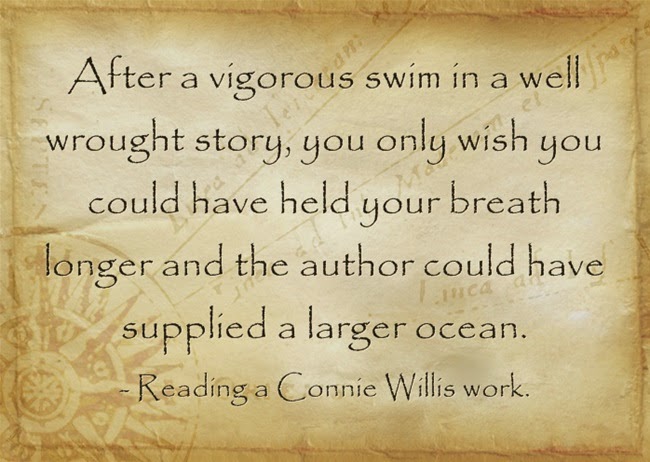Reading a Connie Willis novel is like drowning. Her very first paragraph is a rip tide that lets you get a breath just often enough not to drown you. You spend a lot of time treading water, but the liquid feels so lovely against your skin, a blood warm suspension, and you pray for breath and continued immersion in the same bubble rising to the surface. No ground beneath your feet, but somewhere along the line you learn to stay above water, gain a sense of where land is and strike out in an Australian crawl that you didn’t know you could do. At about the time the book ends, your toes feel the roughness of sand and sea shells and you wade to shore. Welcome to Willis style writing. What will you do, probably what I did. Go dive into another Connie Willis book.
What in heck does she do? The problem is you can’t just sit down and read one of her novels to learn something. Two tiptoes in and you’re out of your depth in story. So I am grabbing a bucketful from All Clear you can’t possibly fall into, but you can shove your head in and peer about.
Bucketful — take a deep breath and kick: By noon Michael and Merope still hadn’t returned from Stepney, and Polly was beginning to get really worried. Stepney was less than an hour away by train. There was no way it could take Merope and Michael–correction, Eileen and Mike; she had to remember to call them by their cover names–no way it could take them six hours to go fetch Eileen’s belongings from Mrs. Willett’s and come back to Oxford Street. What if there’d been a raid and something had happened to them? The East End was the most dangerous part of London.
There weren’t any daytime raids on the twenty-sixth, she thought. But there weren’t supposed to have been five fatalities at Padgett’s either. If Mike was right, and he had altered events by saving the soldier Hardy at Dunkirk, anything was possible. The space-time continuum was a chaotic system, in which even a minuscule action could have an enormous effect.
Dry off your head. Now think about what she did. First she threw a bunch of names and places at you. Then she set up a problem; where are Eileen and Mike who apparently go by other names, real names? They have been gone too long. Five people dead? London and Dunkirk on the same page and practically the same breath. Why is the East End the most dangerous part of London? Raids?! Altering time? Space-time continuum? Well, if you like time travel that last bit wasn’t so hard to swallow. But there is so much to wonder about that you have to keep swimming just to find out what is going on. And then it is too late to get out of the water. You are in for the duration.
With all that tossing of names, places and events, you would think you’d feel over run with information to process. But that is not the case. There is the intimate connection you have formed with Polly who is worried about her friends and their safety in time which does not appear to be playing by the rules. All that in two paragraphs. Better read it again. You only had a couple chances to get a gulp or two of air and probably missed something.
Ready again? Six hours, they’ve been gone. What has Polly been doing while they were gone? Padgett’s? (Those with experience in London know, but the rest of us need more information.) Hey, that’s only an hour away by train, wouldn’t she know by now if there had been a raid? When is this anyway? How did she know so precisely that there were no daytime raids on the twenty-sixth? Clearly you must read for a while before you get the answers you need. Better pack a life vest.
That’s Connie Willis. She dives in and never lets the water grow smooth. There will be a break or two, but the waves are still coming, though you can float on your back for a bit until things get rough again and they will. Gotta love a writer who knows how to throw the reader in and make them love the drenching.

